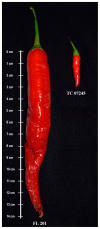Mapping of fruit length related QTLs in interspecific cross (Capsicum annuum L. × Capsicum galapagoense Hunz.) of chilli
- PMID: 29875605
- PMCID: PMC5982179
- DOI: 10.1270/jsbbs.17073
Mapping of fruit length related QTLs in interspecific cross (Capsicum annuum L. × Capsicum galapagoense Hunz.) of chilli
Abstract
Fruit length in chilli is quantitatively inherited trait and selection based on phenotypic performance is tedious and time consuming. To detect QTLs determining fruit length in Capsicum spp., an interspecific F2 mapping population was developed from the cross of C. annuum L. cv. 'FL 201' with C. galapagoense Hunz. accession 'TC 07245'. Fruit length in this cross showed a quantitative inheritance with the population depicting a symmetric distribution in histogram. To map quantitative trait loci (QTLs) for fruit length 400 SSR markers were surveyed on the parental genotypes but only 28 markers were observed to be polymorphic indicating less genetic diversity between the two Capsicum species. Polymorphic markers were then analyzed in F2 population consisting of 210 plants and 24 of these markers were mapped on to three linkage groups (LGs): LG 1, LG 2 and LG 3. Two fruit length determining QTLs designated as paufl2.1 and paufl2.2 were identified and both the QTLs were mapped on to LG 2. The two QTLs together explained 21.78 per cent of the phenotypic variation. Apart from the two QTLs, positive alleles were detected in the small fruited parent 'TC 07245' which might be of potential use in chilli breeding programs.
Keywords: QTL mapping; chilli pepper; fruit length; molecular markers; paufl2.1; paufl2.2.
Figures






References
-
- Barchi, L., Lefebvre, V., Sage-Palloix, A., Lanteri, S. and Palloix, A. (2009) QTL analysis of plant development and fruit traits in pepper and performance of selective phenotyping. Theor. Appl. Genet. 118: 1157–1171. - PubMed
-
- Ben Chaim, A., Paran, I., Grube, R.C., Jahn, M., Van Wijk, R. and Peleman, J. (2001) QTL mapping of fruit-related traits in pepper (Capsicum annuum). Theor. Appl. Genet. 102: 1016–1028.
-
- Ben Chaim, A., Borovsky, Y., Falise, M., Mazourek, M., Kang, B.C., Paran, I. and Jahn, M. (2006) QTL analysis for capsaicinoid content in Capsicum. Theor. Appl. Genet. 113: 1481–1490. - PubMed
-
- Blum, E., Mazourek, M., O’Connell, M., Curry, J., Thorup, T., Liu, K., Jahn, M. and Paran, I. (2003) Molecular mapping of capsaicinoid biosynthesis genes and quantitative trait loci analysis for capsaicinoid content in Capsicum. Theor. Appl. Genet. 108: 79–86. - PubMed
-
- Bosland, P.W. (1992) Chiles: A diverse crop. Horttechnology 2: 6–10.
LinkOut - more resources
Full Text Sources
Other Literature Sources
Miscellaneous
